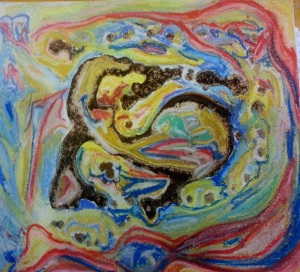My most recent painting, "Sands Through Doorways. . ., " was intended as a Christmas gift, but I was not able to imagine the sand until a few days ago and so couldn't deliver it. Now that reason for the gift is gone, and the painting has taken on a symbolic function at once revealing and heartbreaking.1 After so many months staring at the canvas on the easel next to my kitchen table, I finally figured out how to adjust the sand. Previously, I had used too many colors in the sand, which offered no sense of dimension. Also, I found that the acrylics were too flat; therefore, I used modeling paste to give more weight to the paint, which allowed me to sculpt the sand rather than merely paint it. That seemed to help me feel the dimensions, applying hues to them in several passes, an approach that gave the image some movement.2
The painting's symbolic meaning emerge only while having a beer with a friend during a trip I took to Montreal, a trip that was both escape and medicine. While I watched the head on the imperial stout flutter indecisively, my friend described the recent collapse of his relationship. A while back, my own relationship, which I had hoped would last forever, had tumbled off the steps and into the gutter, and his observations echoed roughly some of my own experiences. I showed him the painting I had finished sometime afterward, and he said, "Yes, that is my relationship."
"The sand is like those minuscule, often unconscious, acts of meanness and viscous disregard that over time tear down the edifice," he said, beer to mouth, knuckle knocking against the brass-topped table. "And the destruction only becomes clear once the structure is no longer of use, its original purpose made defunct." He seemed too certain, full of that early alcoholic euphoria that characterizes the conversation in so many college pubs: wisdom built on uncertainty and the convenience of limited consequence.
"All those wants and needs developed into a personal philosophy that is so hard on relationships. My ex.," he said moving his hands to his sideburns, "was told to assert what she wanted and do so honestly (and it's assumed only her version of the truth mattered). On the face of it that advice seems sound, but it sets up a difficult dynamic in the hands of one who takes it too literally or abdicates her reason for that of the professional, who works for you so does not necessarily have any broader interests in mind. If only one is allowed to express her wants and needs then other is forced, if he wants the relationship to continue, to respond with 'I will provide.' I guess this dynamic can work, it probably has forever, but it seems as though it might cause the couple to travel on parallel, and often diverging tracts that may never converge, without some possibly counter-productive incentive to motivate a merger. Often this incentive is some version of co-dependence, which can be harmful to the identities of those involved."
He took a deep breath, heated up. "It seems better to ask 'what do we need and what do we want?' These questions might lead to building a life together, especially for older couples, who did not have the benefit of growing together both personally and professionally while building their relationship." He stopped and drank, taking a heavy pull from his beer. That last thought increased his sense of hope, it would work wouldn't it if she would just hear it, but that hope was dashed against his recollection of her last words: "I've been sad, but also happy, relieved, hopeful, and peaceful." If the preponderance of synonyms for happy indicate what they seem, then she is 80% happier without him (4 parts to 5). He teetered for a moment, set his beer down and went quiet.
I understood what my friend saw in the painting, but the painting also seemed to suggest that, even though the original function of the edifice is entirely destroyed, beauty remains, perhaps a beauty even more intense than that possessed by the original structure. However, to populate this structure, to make it meaningful, takes great courage, maybe a sense of joy in the sloppiness of life and its possibilities, or a sense of humor to take the poison out of pedantry and self-help that can deform otherwise evolving relationships. Yet those who can see this damage as transformative and embrace the new relationship it opens up--such as one based on mutual discovery and the acceptance of one's quirks and those human flaws that make him unique and (actually) lovable--might learn to live and love beyond individual wants and needs and perhaps discover a joy unforeseen by psychologists and talk show hosts.
______________________
1. If anyone would like this painting, let me know (free of course). This is probably one that I shouldn't keep.
2. This title reminds me of the catch phrase, "Like sands through the hourglass, these are the days of our lives," that played somewhere behind my early childhood. And I recall watching it with my sisters with a some interest for some amount of time. I can't recall why I watched it, what prepubescent struggles I was facing that found some expression there.


